How jeans can be repaired (and when they can’t)
I recently had my vintage Levi’s repaired a couple of times by the team at Blackhorse Lane. The first time for a rip in the knee, and the second to reinforce the crotch seams.
It’s wonderful to be able to do that. The jeans are just as strong, despite being over 50 years old, and I have no need of anything new.
This is more sustainable, of course. But just as important is that it makes the jeans more personal and precious.
When I bought them they had already been repaired several times. Now I’ve added my own repairs - my own steps on their journey - and as a result there is a lot of emotional investment. I think that’s one reason they’ve become one of my favourite pieces of clothing. They are unique, irreplaceable.
Still, they won’t last forever. Jeans can be repaired many times, and look better doing so than any other type of clothing. But there is a limit.
The most common repair on jeans is reinforcing the crotch (above). You might not want to imagine this, but there’s more sweat and bacteria down there, and (depending on your activities and body type) much more friction.
If the problem is caught when the denim is wearing thin, rather than actually blown through, then darning on the inside of the material can be enough.
This is not darning as you know from knitwear, where hand sewing is used to recreate the weave in a small area of the material. (And which we’ve covered before, here.)
Instead, a sewing machine is used to sew repeatedly back and forth on the back of the denim (shown below). This is done again and again, so much that you’re effectively creating new cloth.
The sewer will generally follow the direction of the twill, and use a thread that’s as similar to the colour of the jeans in that area as possible. It does do the same thing as darning knitwear, but rather more intensely, roughly and mechanically.
Sometimes, a piece of spare material is also needed behind the repair, to reinforce it.
On my jeans, I’d noticed that the seams on either side of the crotch were thinning significantly. There was still thread there, connecting the two sides, but you could almost see through it.
In this case darning on the back of the seam was sufficient (below).
Where the denim on the knee had ripped, however, a new piece of material was also needed on the back. This can be another piece of denim or a piece of softer cotton: the former is stronger but stiffer, the latter softer but not necessarily as strong.
When I had my first pair of bespoke Levi’s repaired, they used denim. Blackhorse Lane, who repaired my vintage ones, preferred to use softer cotton. Either way, the material is then darned on the back in the same way.
“My advice is to bring in jeans before they actually rip through - when they’re just thinning,” says Lilly at Blackhorse Lane. “If you do that, chances are we won’t need to put any backing on, and the result won’t be as thick.”
This is particularly good advice in the crotch because the material needs to shape to your legs and seat, and you’re more likely to notice any extra thickness.
Pictured above is a large repair on the knee of a pair of jeans. Lilly and the team have also put patches on the outside of knees for issues like this, but only in exceptional circumstances.
“If someone is on their knees a lot, through their work, then it can be good to have an extra layer of denim,” says Lilly. “But it’s not normally required. The only other time we’ve done it was when a gentleman had spilt bleach on his jeans, and a patch over the top was more attractive than the stains.”
Another common job is repairing the buttonholes on the fly and waistband. Perhaps surprisingly, this has to be done by hand, so you effectively end up with hand-sewn buttonholes like on bespoke trousers.
That’s necessary because the particular machine can only sew an entire buttonhole, and then cut the material in the middle. Trying to do that over the top of an existing buttonhole would be pretty messy.
Entire waistbands can also be replaced, if needed, and pocket bags replaced too.
“This happens quite a lot with other jeans because they use light pocket bags,” says Lilly (above). “This makes them more comfortable at the start, but they’re often the first things to go.”
A small hole or rip can be seen closed, but often the whole bag has fallen apart. Apparently, men rarely bring these in to be replaced until there’s almost nothing left.
So what can’t be repaired?
“Basically, when the material everywhere just gets too thin,” says Lilly. “When you can hold it up to the light and virtually see through it.”
At that point, the rips are going to come everywhere fast. So you’re effectively making an entire new pair jeans inside; it’s better to start again.
I think my jeans still have a good few years left. Particularly as I don’t wear them every day - and not for anything as manual as they were probably originally used.
So I’ll go on patching and darning for a good while yet.
For details on how much jeans can be altered, rather than repaired, see previous article here.
Blackhorse Lane repair any jeans, from them or any other maker. Take them to the Coal Drops Yard shop to discuss details.
Prices range from £20 for a small hole to £35 for a large one and £60 for replacing a pocket bag.
Other places that do repairs in London, and I would recommend are:
- Soldier Blue: linked to Son Of a Stag and Rudie’s repair and alteration offshoot.
- The Denim Doctor, been doing the alterations for a long time.
- Hang Up Vintage - Ben, a vintage dealer who makes and re-engineers vintage clothing
Pictured above, the pile of repairs waiting at Blackhorse Lane; below, their Singer darning machine. All photography, courtesy of Blackhorse Lane.


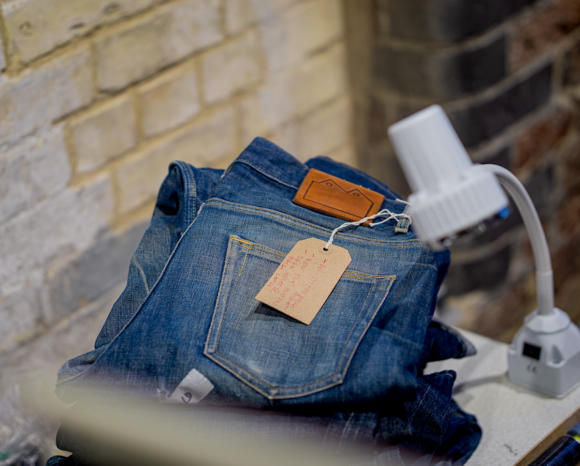
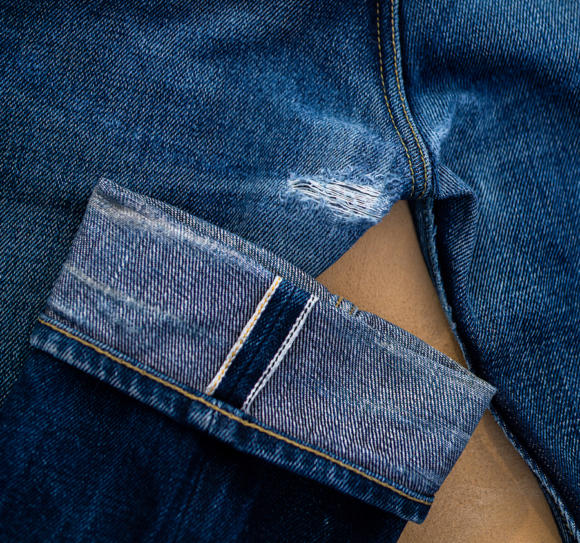
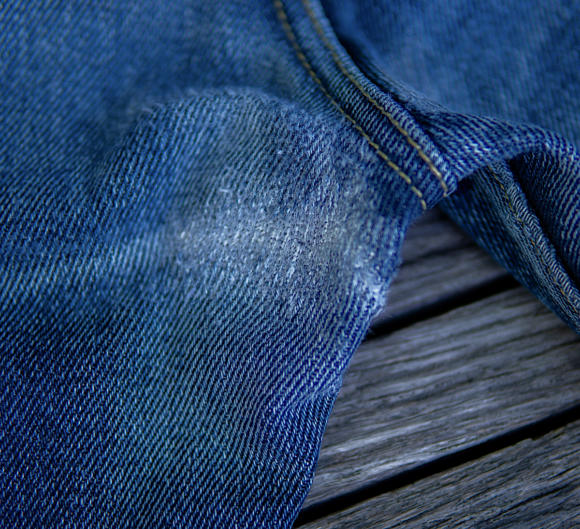
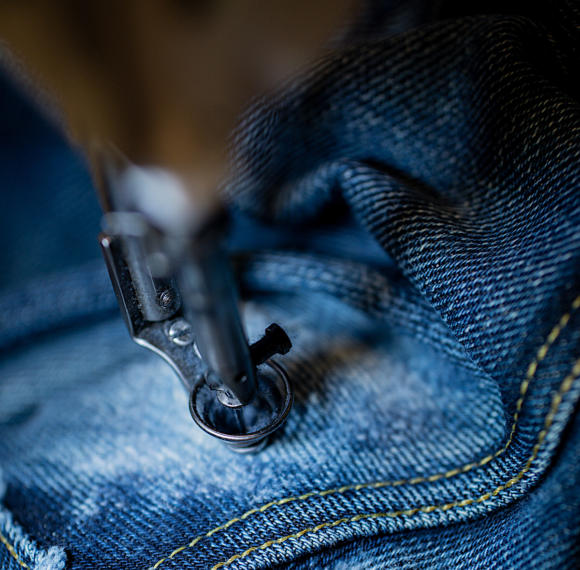
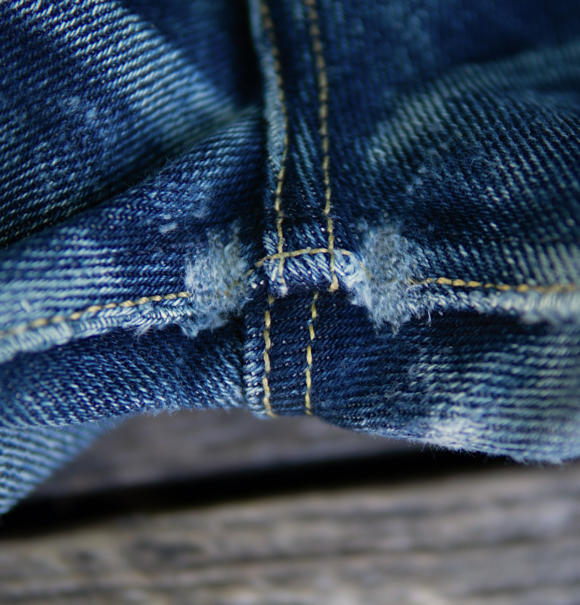
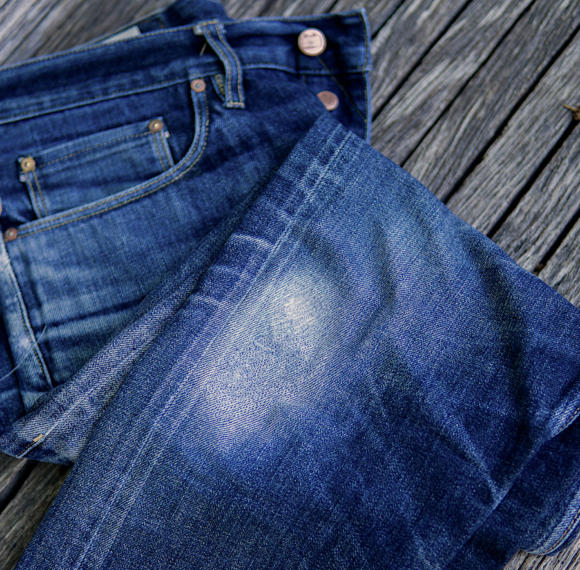
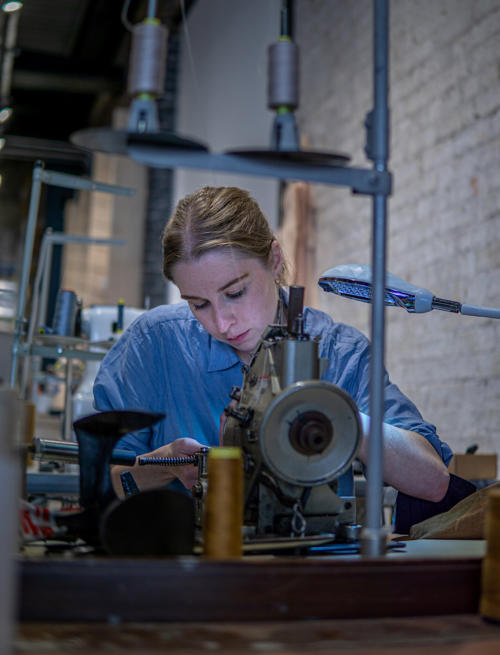
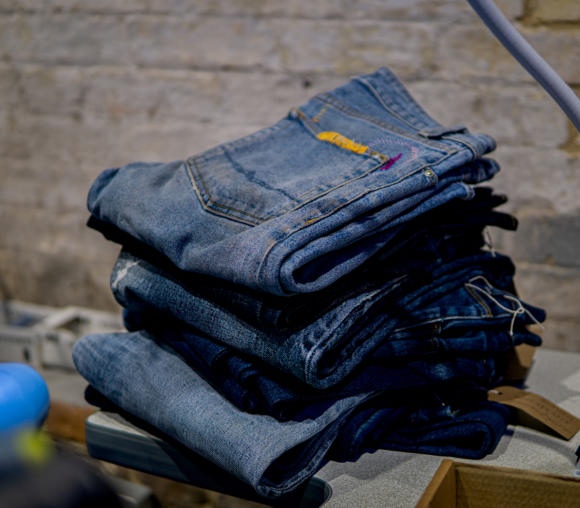
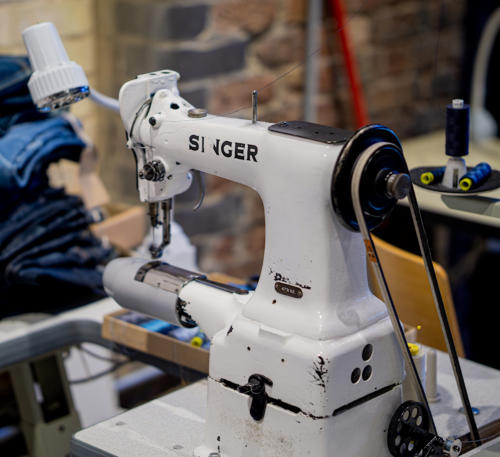


























Hey Simon, I sent 2 x pairs of my BHL jeans back for repair from Melbourne, Australia and have to say the team did a wonderful job. By far the best repairs I have had done on jeans.
given how much character jeans take on with wear, I think it’s a shame to simply replace and not repair them. I would thoroughly recommend BHL’s jeans and repair service to the PS family.
Thanks Tim. Is there anywhere in Australia that does this? I feel like there must be a good denim store?
There are a couple different of options Simon – one in Fitzroy and another in the CBD – but the repairs from BHL are better and less visible.
Ah OK, good to know
Hi Tim. I assume you are referring to the store that is now called Urahara? Do P&P still do repairs? Who is your denim repairer in the CBD?
we are all mindful of sustainability & making good & mend especially if they are ‘old faithfuls’ with their wear marks & creases. But there must surely come a point where the air miles outweighs the sustainability equation. We are kidding ourselves sometimes about sustainability & yet having air miles attached to materials, production or repair when they come from the other side of the planet. We should surely consider what is available within our own shores wherever possible.
They’re both big factors Steve, absolutely. I don’t think anyone is saying that air miles aren’t a crucial part of the equation. But of course that aspect is mostly up to consumers rather than brands. And it’s all helpful
Hi Simon,
We are fortunate in London & the UK to have a wide array of shops, brands etc and repairers of shoes, jeans, tailoring, knitwear so it’s hard to imagine sending BHA halfway around the planet to be repaired. But it is customer driven & no retailers will turn down business, but is this sustainable?
You’d need to look at it more closely to make a comment on the sustainability of that – and it would likely not be a straight comparison. For example comparing water usage in new cotton and jeans, to carbon emissions in air miles.
But you would really hope that there were a way of doing this more locally.
Michael Pascalis who runs Alteration by Master in Sydney’s CBD has done a great job with my denim repairs.
Nice, thanks
Hey Tim, Hi Si! Tim, my pal Lee May lives in Aus and has a denim biz doing repairs and making super high quality jeans. Check him out on Insta @EVERWEAR_AU
Best
Oli
Nice, thanks Oli
I am a regular at the Coal Drops Yard shop and I can’t say enough good things about the products and the team! Will, Lilly, and all the rest of the team are kind, attentive, knowledgeable and always a pleasure to talk to about denim, clothes or anything else in general. I haven’t used them for repairs yet but I’ve had some jeans altered to let out the thighs and Lilly did such a great job. Highly recommend.
Huit will repair their Jeans free for life
Thanks Jamie, great to know, just like BHL.
Will they also repair other brands’ jeans, as in my example here?
So does Black Horse Lane Ateliers 🙂 I dropped my pair few weeks back, expecting them back soon.
nudie offers repairs for life too, but only for nudie jeans
Such a great article like the cashmere care one cause good end expensive clothes shouldnt be replaced every 1-2 years. It would be very interesting to make an article about the bespoke jeans you have and what would you make different if you where to order them now.
Sure Georgios.
I did do one article a few years ago reflecting on them – here.
And I did one about altering jeans here, including those bespoke ones, which reflected a bit of how preferences have changed (eg slightly wider legs)
Great article Simon, some helpful pointers as well. Purchased my first pair of quality denim, about a year and a half ago from Black Horse Lane, beautiful NW1’s in Turkish denim. Just bought a new pair actually in Japanese, however my first pair are starting to ever so slightly thin at one spot around the crotch. Great to have Lilly’s insight into the fact, sooner rather than later might be the best time to reinforce that area.
If the fabric is starting to thin after 18 months, it cant be very good quality.
Not really Josh, it depends a lot on the weight and how it’s been worn. If you cycle in most denims every day, they’ll go through in the crotch quicker than that
I found this article very interesting, not for the advice given on repairing jeans but for the way it highlights how things have changed.
,I was born in the forties. When I was a child my mother darned my socks and sweaters and turned my shirt collars. Often the clothes being repaired were hand-me-downs.
it may be because of those memories that I consigned two pairs of jeans that wore out during lockdown to the shoddy bag and wouldn’t contemplate buying second-hand “vintage” clothes. That said, like many of my generation I went through a short-lived period of patching my jeans with non-matching material whether they needed patching or not.
It’s an age thing.
Thank you Thorn, that’s interesting – so even though you grew up with that mending mentality, you wouldn’t do on jeans today?
Do you think that’s a reaction against that kind of upbringing, or not?
Exactly that.
I’m was in the same position as Thorn. Both my mum and Gran repaired all of my clothing(both worked in textiles in Lancashire) – even wool sweaters were unpicked and wool reused.
Growing up in the 70s,jeans were very much a luxury item(expensive) and I don’t remember having a pair with a full set of rear pockets.
Although I don’t repair to the same extent, I take very good care of my clothing.
Derek Guy has mentioned that his mother didn’t understand why her son would buy vintage because, to her, secondhand clothing was a sign of poverty.
Yes, the attitude change over time is interesting isn’t it?
I think we’re in the process of swinging the other way. To my children’s generation it will seem very strange, in fact obviously unethical, to buy and throw away so much.
There’s a cultural dimension here, too. My mother’s attitude was similar to Derek Guy’s mother’s, and I don’t think it’s a coincidence that both are Southeast Asian. In a society where poverty is widespread, clothing can be a way to separate yourself from that poverty (cf Congolese sapeurs).
By contrast, among the American elites who created Ivy, hand-me-downs were a signifier of wealth, rather than poverty.
I was born much later, but I totally see where you’re coming from. Especially my grandmother used to do that; she was so parsimonious we used to say she would eat the same thing twice if it didn’t smell. At the same time, whatever she owned was always the cheapest thing available so not exactly something you’d want to inherit.
But once I started buying high-quality clothes, I started liking the idea of keeping them for as long as possible. First, it saves me a lot of money, second, it’s more environmentally friendly and third, it’s a way to appreciate the craftsmanship. Or at least I can imagine that if you make something with your own hands, you take pride in it and hope that whoever buys it won’t throw it away after a year or two.
Hi Simon, Any plans to revive the trunk show calendar? Did not notice it was gone until just now. Re-launch of the calendar would be highly appreciated! Thank you!
Hi V,
No I’m afraid not. It was a lot of work to put together, and in the end artisans didn’t advertise enough to make it viable. It was a shame
If you only have one pair do you just gradually change the color of your denim-coherent wardrobe as it fades with wash?
I have more than one pair of jeans, and these have always been the same colour as they were vintage.
But if you only have one pair, yes you would have to change slightly. Or you slow down the washing to slow down any colour fade.
The clothes I wear with jeans I’ve had for a decade are different to the ones I wear with new jeans for this very reason.
It’s one of the nice things about them, tbh.
All for caring and repairing good quality clothes! And when its beyond repair I still find myself wearing stuff around the house that’s starting to fall apart. Have to say that’s only partly an ethical issue though, when you don’t have a lot of disposable income by nature you’d be more frugal (generally speaking). A modern wrench in this attitude is unfortunately the supply of poor quality clothing. Buying new is often easier and cheaper then actually repairing. The upcoming inflation cycle in our economy might slighty alter this dynamic.
Likewise. Probably an age thing as well for me, I want to waste much less, so will keep worn out clothes for knocking around the house and garden or shoes that are past it for walking the dog.
As Thorn and others above have mentioned re handmedowns and repaired clothes, in the past I wanted to get away from that = I wanted new, smarter clothes. I’m much more relaxed about it now, and will repair clothes and buy second hand and vintage.
Interestingly, I have found that with the economic situation of the past 18 months and the uncertainty of the future and the coming inflation I have now found I am much more driven towards smarter and better quality clothes that will last ( I may have already been moving that way, but I am consciously avoiding dressing down now as I find I feel shabby. When I was mid-late teens and started buying my own clothes I wanted to dress smartly too, sporty and Ivy.
Chatting with a friend a few years ago, he mentioned that after the 2008 Financial Crash he found himself out of work he tended to dress as smartly as he could. When his situation improved again, he was happy to dress down again, frayed jeans/scuffed boat shoes etc.
Poor quality clothing that’s available now often looks quite good. I have bought what I thought were good clothes over the years, only to find they fall apart at the seams, wear holes or pill easily. That and frustration with fit due to the slim/skinny fit trend is probably how I ended up here. I now want to know what my clothes are made of and how they are made and that they’ll last as well as being well fitting and stylish.
Is it only expensive / high-end denim that’s worthwhile to go to the effort and expense or repairing? I frequently go through the pockets of my jeans, but paying £60 to get new pockets sewn in, when the jeans only cost £50 or so in the first place, seems strange to me, even though I very much like the idea of it from a sustainability point of view. My jeans are Levi’s (non vintage or Uniqlo mostly. Would you bother repairing them or just bin them! (And buy a more expensive pair that would be worth repairing).
.
Well, I think it’s still worth repairing. Because, from a sustainability point of view, you’ve used fewer resources that way – a new pair did not have to be made. And because jeans are best when worn in and loved, so chances are the pair you already have are better in that regard
Come on now, this is a totally idealistic response, I can’t believe you’d actually follow your own advice if you were actually in such a situation, instead of having the luxury of a wardrobe full of bespoke items and even bespoke denim and chinos.
By all means save up and buy a more expensive pair which will deserve such care in the future, but don’t waste money on skilled labour for items that don’t deserve it.
The point I meant to make is that the jeans he has will probably be nicer than the ones he was going to buy, at the same price. So don’t just replace those.
I’m not saying he should buy cheaper new jeans rather than buy better quality ones, for the sake of sustainability. In nothing else, the better quality ones might last longer.
I guess correct answer would be, depends on how much you care about this particular pair. If you do, you’ll pay, if you don’t, you’ll bin and get new. In couple years I’ll have the same dilemma with my shoes. Is it worth paying 160£ for resoling for shoes I got discounted for 80-120£. And I know for 2 pairs I won’t be paying.
And how would “better quality” jeans last longer? Above a certain quality point, denim is… denim? Weight matters more. Make will make it last longer?I can’t recall last time a piece of clothing broke at the seams once I stopped shopping at primark.
True Martins, the denim is the most important thing. More expensive jeans do tend to use heavier denims though (more cotton, so to that extent more expensive) and sometimes woven more densely.
Also, see making quality points on the Blackhorse Lane article.
Separately, does it really cost £160 for your resoling?
actually trickers factory charges 160£. and loake 120£. I dread to think what I’ll do when my yeossal or meccariello will need resoling…
Thanks. Is that more of a full refurbish?
Tony’s Heel Bar will do a simple resole on a pair from someone else
for trickers after seeing some wonders on their Instagram, I fully understand the price. (not sure how often they refuse the repairs) for example dog chewed the shoes, they even swap out panels during refurbishment. but for the rest of them… I guess after “my” guy left the shop in canning town, might just as well inquire at Tony’s heel bar.
With shoes it is not really much of a dilemma for me. Provided the upper doesn’t have any issues, the shoes are worth more to me after a usually painful break in period, so I would rather resole than buy new. And it doesn’t come cheap here in Copenhagen (you are talking about a hundred US dollars for a new half sole and heel pad, I’ve yet to try a full resole). I would totally send my Loake shoes back to the factory for a full resole if that is the price.
Lister, one option might be to have a crack at mending them yourself. The cost of materials of basically zero, so all it’s costing you is time.
If you’re going to bin them otherwise, the worst outcome is you learnt something.
I agree with Martins, it depends on how much you care. I used wear a pair of shoes from River Island at uni which I absolutely loved. I had them resoled, repaired, patched etc etc until after 7 years they passed away in peace. Probably paid 4 times over the price of the shoes, in repairs.
Repairing and reusing will always be more sustainable than purchasing a new one – be it clothes, furniture, electronics. I grew up in Pakistan where we would repair literally every single thing in the house to the nth degree. A positive extranality of cheap labour. And obviously the cost of labour is what makes repairs prohibitive here in the UK and encourages throw away culture. Discussion for another day.
Hi Simon, sorry for the off-topic question but I couldn’t find a place for this.
Do you have any recommendations for bedsheets & duvet covers? I’m currently looking and am not making progress.
No, sorry. I do like linen all year round, but I’ve never looked at a specific high-end brand
I can recommend sheets and covers from Peter Reed Textiles – high percale Egyptian cotton. I think from John Lewis, if I remember correctly.
I received a pair of Anglo Italian jeans back yesterday from Son of a Stag – they did a really good job repairing a blown out crotch. It wasn’t cheap (£40) but in the context of a £240 pair that didn’t go more than a year before wearing through, I think it was worthwhile. The repair is nearly invisible on the outside – really impressive. The whole area has been reinforced with a patch so that it feels much stronger.
I was slightly worried about Anglo’s quality after this happened (and I am still a little, to be honest) but the guy in Son of a Stag said that this is very frequently the first area to go, even if (as I don’t) you don’t cycle in them. He said that frequent washing helps.
Bought my first pair of Levi’s at a market in Bradford in the late sixties. They were 10x the price of British jeans, so I saved up for a long time. They were all shrink to fit, and new, the cloth was like hairy black cardboard, but they wore and aged beautifully.
We would repair and customise them with embroidered patches. I remember the stall had a poster up of two girls walking away from the camera in Californian sunshine. One had a beautiful pair of patched repaired jeans, and the other had a brand new pair with a little embroidered patch which said “running in, please pass”.
Lovely
Can you buy Wranglers? They are better and cost less than 1/2 the price of Levis; I don’t know of anyone who buys Levis these days in the states. best wishes
Just to be clear George, these are vintage Levi’s not new ones. And my other Levi’s are bespoke, which is not a service Wrangler offers.
Out of interest, how are new Wrangler better in your experience?
I’m having an incredibly hard time finding washed and sanforized high-rise non-slim fit jeans that go well with tailoring online, can’t tell whether brands like OrSlow, Studio d’Artisan and the myriad of other japanese selvedge jeans makers carry those because the rise is seldom mentioned and seems to differ from website to website. I have already gotten a pair of Naked and Famous but they’re mid-rise at best, despite the fanfare (I also figured I hate raw denim, it’s so uncomfortable). Any suggestion?
Have you tried shops that stock a lot of brands, such as Clutch Cafe or Son of a Stag in the UK? Or other denim specialists in other countries. Often the staff there are very good, and if you give them a call they’ll quickly be able to pick out the best style for you.
Admittedly, I haven’t, but I’ll give it a whirl and let you know how I fared. I got the N&F at Stuarts but they took a freakishly long time to get here (on top of having to dish out extra cash upon picking up the item, unexpectedly, must’ve been customs taxes or something, didn’t happen with the PS everyday denim tho) and that turned me off from ever purchasing anything from the UK again. In hindsight, that had probably a whole lot more to do with italian customs and postal service being… well, very italian as per usual, than anything.Thanks for the advice!
Try Livid Jeans. They are a high rise jeans maker and have a range fits from skinny to very wide. Well made with good materials
I got two pairs of bespoke jeans from High Cuff (formerly know as Tailor’s Lab) in Prague, Czech Republic. They come with a lifetime warranty, I had them repaired several times https://www.facebook.com/highcuff
He can repair other clothes too and the prices are very reasonable.
Just like Simon, I embraced the idea of my clothes getting old with me instead of replacing them, the oldest thing I own and still wear is a Carhartt shirt that’s currently 10 years old (I bought it brand new for about 60 pounds or so).
I’ve tried hard to love raw denim but finally switched back to pre-washed a couple of years ago. I’ve had several pairs of Edwins and a pair of 3Sixteen, which were quite expensive and didn’t last long. As you mentioned, the crotch would blow out pretty quickly, even without cycling, and then need repairs. I think the problem is that many brands were advising against washing them for the first six months to get better fades. But the lack of washing apparently exacerbates the problem of them falling apart. I don’t mind the repaired look for casual but found I couldn’t then dress them up. In the end, I switched to Rag & Bone jeans and couldn’t be happier. That said, I stopped by Blackhorse Lane earlier this week and was tempted by their made to measure service!
Hey Simon,
Great article. I have an old pair of Levi’s that I love but the patch on the back is ripped and starting to fall off. Would you recommend trying to have it repaired/replaced? I know Levi’s offers an official tailor shop now (not sure if they could replace it), or should I just let it go with grace and the mindset “if it falls off it falls off.”
Best,
Ryan
I think the latter myself Ryan